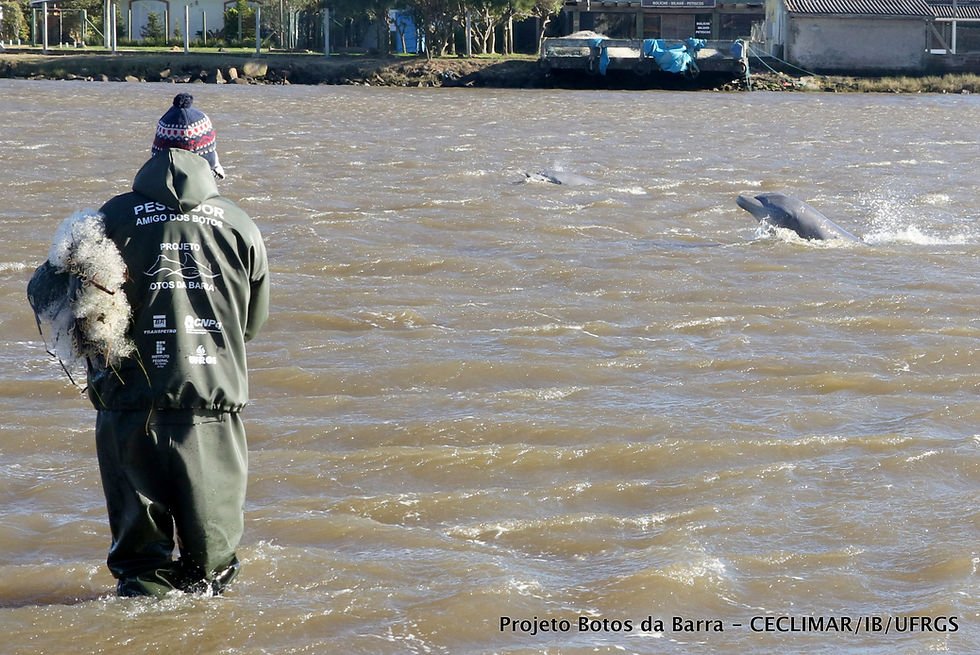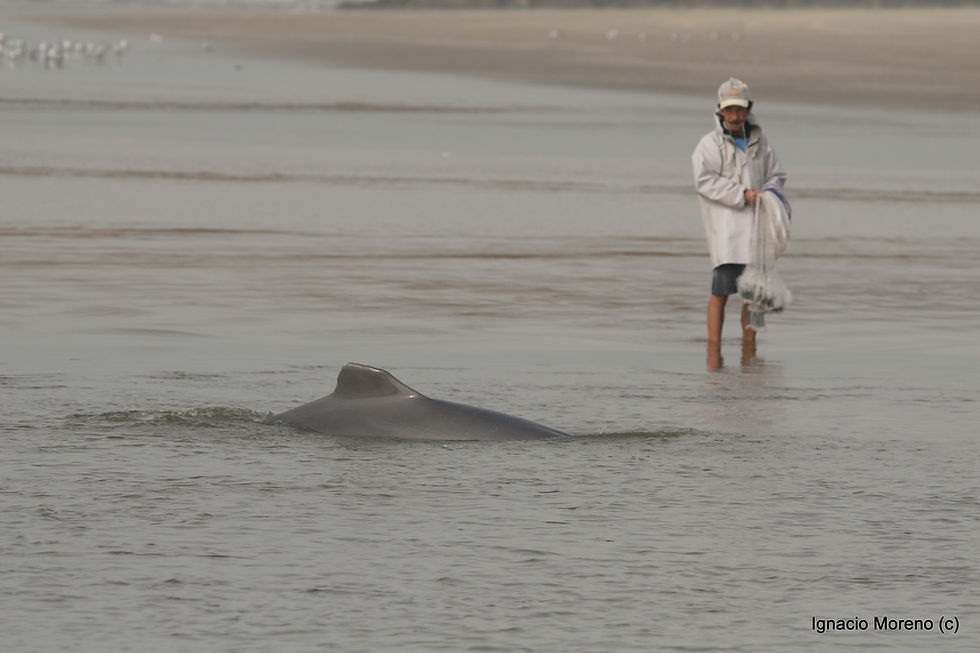Dolphins and humans: best fishing buddies
- Bate-papo com Netuno

- 9 de abr. de 2020
- 4 min de leitura
Atualizado: 5 de jun. de 2020
By Carla Elliff
A friendship that is as beautiful as it is unlikely.

Illustration by Joana Ho
One of the most traditional seafood dishes in southern Brazil is grilled mullet, and the story of how this fish gets from the ocean to your plate in two special places is amazing. The artisanal fisheries that captures mullets in southern Brazil is believed to have indigenous origin, later being influenced by immigrants from the Azores Archipelago who settled in this region of the country. The tradition has since been passed down from generation to generation.

Artisanal fisherman using a casting net to capture mullets at the inlet of the Tramandaí River (photo by Ignacio Moreno).
But artisanal fishermen and mullets aren’t the only players in this story. Dolphins are a crucial ally for fishermen, characterizing what is called a cooperative artisanal fishery.
The species of dolphin involved here is Tursiops gephyreus, whose close relative is commonly known as the bottlenose dolphin in other parts of the world. In fact, the genus of this species (Tursiops) is the same as that of the character Flipper (Universal Studios, 1996)! These cetaceans are intelligent animals and have highly complex behaviors, including when they communicate and socialize. They orient themselves and hunt using echolocation, a process where an animal emits a sound and perceives the echoes produced to calculate the distance between objects. By combining their echolocation strategy with a partnership with local fishermen, these dolphins developed a new way to eat.

The Tursiops gephyreus dolphin (photo by Ignacio Moreno).
There are currently only two places in the world where this fishing friendship ritual takes place: in the estuary of the municipality of Laguna (SC) and at the inlet of the Tramandaí River, between the municipalities of Imbé and Tramandaí (RS). Historical reports suggest that this practice was also common in the estuaries near the municipalities of Araranguá (SC) and Torres (RS) and in the Patos Lagoon (RS), but this phenomenon has become much rarer.
You must be asking yourself: why does this cooperative fishery only happen in these two places? How did the dolphins learn to fish with humans? Can this fishery harm the dolphins?
Questions like these, many without a precise answer, have motivated scientists to do research on this occurrence, such as Professor Ignacio Moreno from the Federal University of Rio Grande do Sul (UFRGS), who so kindly supplied pictures taken by himself and his colleagues to illustrate today’s post! Prof. Ignacio is the coordinator of the Projeto Botos da Barra, carried out within the Centro de Estudos Costeiros, Limnológicos e Marinhos (CECLIMAR) of UFRGS. The objective of this project is to value and conserve the cooperative fishery, guaranteeing its continuity and the livelihood of the fisherman community and dolphins of the Tramandaí River inlet.

Dolphin-friendly fisherman (pescador amigo dos botos), a partner of the Projeto Botos da Barra conducted by CECLIMAR/IB/UFRGS (photo by Ignacio Moreno).
But what happens exactly in this partnership?
When the dolphins detect a school of mullets at the inlet of the Tramandaí River, they chase the group and lead them towards the shore. The fishermen, armed with their casting nets (a type of circular net), are there prepared and waiting for the characteristic telltale signs the dolphins make with their heads, indicating that it is time to throw their nets over the cornered fish. Yes, the dolphins nod to the fishermen to let them know when the mullets are there! This way, the fishermen are able to catch more fish in a single throw of their nets and it is easier for the dolphins to catch their mullet, since the fish become disoriented with the net hitting the water.
Dolphin catching a mullet (photos by Ignacio Moreno).
Fishing with a casting net is considered a sustainable practice for many reasons. For example, since this is a small-scale fishery for either local of subsistence consumption, the pressure over this resource is much lower than with industrial fisheries. Moreover, by using an adequate mesh size, the casting net becomes a selective fishing gear, capturing only adult fish of commercial importance.
With years of comradery and mutual help, true bonds have formed with this interaction. The fishermen, who consider the dolphins their friends, can tell them apart by name and know which one is helping (or sometimes getting in their way). There is Geraldona, Rubinha, Chiquinho, Lobisomem (known as being particularly greedy and even learned how to open the casting net underwater!), Manchada... A real family!

Artisanal fishermen casting his net with the help of Geraldona (photo by Ignacio Moreno).
However, there are dark clouds in this story as well. Urban occupation along the northern coast of the state of RS has grown intensely and in a disorganized way, leading to environmental impacts such as the suppression of dune fields, the loss, fragmentation and deforestation of native vegetation, the generation of excessive waste, the contamination of waters, and intense noise and traffic from boats and nautical sports. Moreover, the craft of being an artisanal fisherman is considered socially vulnerable: although this is an option for sustainable fisheries, it is not highly valued and there are less young people learning the trade.

Multiple uses at the inlet of the Tramandaí River, RS (photo by Ignacio Moreno).
This scenario reinforces the need for individual and collective measures to improve our environment. For example, after zoning laws and monitoring came into effect in 2016, the dolphins began to appear more frequently during the summer – a time of year when they were not so common, possibly due to the intense tourism and overpopulation in the area during the season.
So, remember: if you are near the northern coast of RS or in Laguna (SC), go a bit earlier to the beach and get your fish directly from the dolphins’ friends!

Artisanal fisherman during the mullet season in Tramandaí, RS (photo by Elisa Ilha).
To know more:
Projeto Botos da Barra:
botosdabarra@ufrgs.br
Guia de apoio pedagógico para educadores: interação entre pescadores, botos e tainhas: aprendizados sobre cooperação, tradição e cultura. Eliza Berlitz Ilha e colaboradores. Porto Alegre: UFRGS, 2018. 90p.
#marinesciences #cetaceans #dolphin #fishing #cooperativefishing #sustainablefishing #carlaelliff #joanaho










Comments